V- BLAST : Speed and Ordering PowerPoint PPT Presentation
Title: V- BLAST : Speed and Ordering
1
V- BLAST Speed and Ordering
- Madhup Khatiwada IEEE New Zealand
Wireless Workshop 2004 - (M.E. Student) 2nd September,
2004 - University of Canterbury Alan MacDiarmid
Centre, Industrial Research Ltd. - Supervisor Dr. P. J. Smith Lower
Hutt, Wellington
2
MIMO Wireless System
- Multiple Input Multiple Output (MIMO)
- Multiple antennas at source and destination.
- Motivation Current wireless systems
- Capacity constrained networks.
- Issues related to quality and coverage
- MIMO increases capacity
- MIMO uses independent channel fading due to
multipath propagation to increase capacity. - No extra expensive bandwidth required !!
- Multiple independent samples of the same signal
at the receiver gives rise to diversity.
Channel H
N TXers
M RXers
3
System Model
R received vector H quasi-static channel
matrix s transmitted vector n white Gaussian
noise vector
Diversity exhibited - Spatial diversity
- Transmit diversity - Receive diversity
4
Spatial Multiplexing Detection
- Maximum Likelihood (ML) optimum and most time
consuming detection method - Linear detection
- Zero-Forcing (ZF) pseudo inverse of the channel,
simple - Minimum mean-squared error (MMSE) simple
detection with intermediate performance
- Simulation Parameters
- Number of Antennas 4 x 4
- Modulation Scheme BPSK
- Channel Model Flat Rayleigh Fading
5
V-BLAST
- V-BLAST
- extracts data streams by ZF or MMSE filter with
ordered successive interference cancellation
(SIC) - Steps for V-BLAST detection
- Ordering choosing the best channel
- Interference Nulling/ Reduction using ZF or
MMSE - Slicing making a symbol decision
- Canceling subtracting the detected symbol
- Iteration going to the first step to
- detect the next symbol
- Simulation Parameters
- Number of Antennas 4 x 4
- Modulation Scheme BPSK
- Channel Model Flat Rayleigh Fading
6
Key references in the literature on the subject
matter
- Foschini, G. J. and Gans, M. J., On limits of
wireless communications in a fading environment
when using multiple antennas, Wireless Personal
Communications, Vol. 6, pp. 311-335, 1998 - Hassell, C.Z.W., Thompson, J., Mulgrew, B. and
Grant, P.M., A comparison of detection
algorithms including BLAST for wireless
communication using multiple antennas The 11th
IEEE International Symposium on Personal, Indoor
and Mobile Radio Communications, Vol. 1 , pp. 698
703, 18-21 Sept. 2000 - Golden, G. D., Foschini, G. J., Valenzuela, R.
A., and Wolniansky, P. W., Detection algorithm
and initial laboratory results using V-BLAST
space-time communication architecture, IEE
Lett., Vol. 35, No. 1, pp. 14-16, January 1999 - Benjebbour, A., Murata, H. and Yoshida, S.,
Comparison of ordered successive receivers for
space-time transmission, Vehicular Technology
Conference, 2001. VTC 2001 Fall. IEEE VTS 54th
, Vol. 4 , pp. 2053 - 2057 , 7-11 Oct. 2001
7
Issues of Ordering and Speed
- Ordering
- Optimal ordering plays a significant role in
achieving high performance - In V-BLAST, the best channel is picked based on
highest SINR, but picking up channels based on
highest SINR value doesnt seem to be the
optimal way of ordering. - Switching
- Switching based on SINR or Eigenvalues of the
channel helps in reducing the computational time
by adding very little complexity to the system. - Switching is a scheme in which the receiver
switches its detection technique from V-BLAST
MMSE to simple MMSE depending upon the channel
condition (either SINR values or eigenvalues of
the channel).
8
Significance of Optimal Ordering
- Simulation Parameters
- Number of Antennas 4 x 4
- Modulation Scheme BPSK
- Channel Model Flat Rayleigh Fading
- Picking the first best channel can effect
significantly in the whole system performance
9
Significance of Switching
Simulation time reduced by nearly 60 at 10 db
SNR case
- Simulation Parameters
- Number of Antennas 4 x 4
- Modulation Scheme BPSK
- Channel Model Flat Rayleigh Fading
- Switching allows us to trade off performance
with time
10
Significance of Ordering and Switching in
Overloaded system
- Simulation Parameters
- Number of Antennas 4 x 2
- Modulation Scheme BPSK
- Channel Model Flat Rayleigh
Fading
- For systems with less receive antennas, optimal
ordering can be a crucial issue for system
performance
11
Conclusion
- Optimal ordering plays a vital role in increasing
the performance of V-BLAST systems with MMSE. - Switching techniques may be useful in reducing
processing time while adding very little
complexity to the system.

